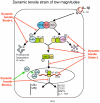Regulation of chondrocytic gene expression by biomechanical signals
- PMID: 18304028
- PMCID: PMC4967411
- DOI: 10.1615/critreveukargeneexpr.v18.i2.30
Regulation of chondrocytic gene expression by biomechanical signals
Abstract
Cartilage is a mechanosensitive tissue, which means that it can perceive and respond to biomechanical signals. Despite the known importance of biomechanical signals in the etiopathogenesis of arthritic diseases and their effectiveness in joint restoration, little is understood about their actions at the cellular level. Recent molecular approaches have revealed that specific biomechanical stimuli and cell interactions generate intracellular signals that are powerful inducers or suppressors of proinflammatory and reparative genes in chondrocytes. Biomechanical signals are perceived by cartilage in magnitude-, frequency-, and time-dependent manners. Static and dynamic biomechanical forces of high magnitudes induce proinflammatory genes and inhibit matrix synthesis. Contrarily, dynamic biomechanical signals of low/physiologic magnitudes are potent antiinflammatory signals that inhibit interleukin-1beta (IL-1beta)-induced proinflammatory gene transcription and abrogate IL-1beta/tumor necrosis factor-alpha-induced inhibition of matrix synthesis. Recent studies have identified nuclear factor-kB (NF-kB) transcription factors as key regulators of biomechanical signal-mediated proinflammatory and antiinflammatory actions. These signals intercept multiple steps in the NF-kappaB signaling cascade to regulate cytokine gene expression. Taken together, these findings provide insight into how biomechanical signals regulate inflammatory and reparative gene transcription, underscoring their potential in enhancing the ability of chondrocytes to curb inflammation in diseased joints.
Figures




Similar articles
-
Biomechanical thresholds regulate inflammation through the NF-kappaB pathway: experiments and modeling.PLoS One. 2009;4(4):e5262. doi: 10.1371/journal.pone.0005262. Epub 2009 Apr 16. PLoS One. 2009. PMID: 19370157 Free PMC article.
-
Biomechanical signals inhibit IKK activity to attenuate NF-kappaB transcription activity in inflamed chondrocytes.Arthritis Rheum. 2007 Oct;56(10):3284-96. doi: 10.1002/art.22933. Arthritis Rheum. 2007. PMID: 17907174 Free PMC article.
-
Role of NF-kappaB transcription factors in antiinflammatory and proinflammatory actions of mechanical signals.Arthritis Rheum. 2004 Nov;50(11):3541-8. doi: 10.1002/art.20601. Arthritis Rheum. 2004. PMID: 15529376 Free PMC article.
-
Regulation of biomechanical signals by NF-kappaB transcription factors in chondrocytes.Biorheology. 2008;45(3-4):245-56. Biorheology. 2008. PMID: 18836228 Free PMC article. Review.
-
Signal transduction by mechanical strain in chondrocytes.Curr Opin Clin Nutr Metab Care. 2003 May;6(3):289-93. doi: 10.1097/01.mco.0000068964.34812.2b. Curr Opin Clin Nutr Metab Care. 2003. PMID: 12690261 Free PMC article. Review.
Cited by
-
Intervertebral disc degeneration and osteoarthritis: a common molecular disease spectrum.Nat Rev Rheumatol. 2023 Mar;19(3):136-152. doi: 10.1038/s41584-022-00888-z. Epub 2023 Jan 26. Nat Rev Rheumatol. 2023. PMID: 36702892 Review.
-
Engineering lubrication in articular cartilage.Tissue Eng Part B Rev. 2012 Apr;18(2):88-100. doi: 10.1089/ten.TEB.2011.0394. Epub 2012 Jan 6. Tissue Eng Part B Rev. 2012. PMID: 21955119 Free PMC article. Review.
-
Jaw closing movement and sex differences in temporomandibular joint energy densities.J Oral Rehabil. 2018 Feb;45(2):97-103. doi: 10.1111/joor.12588. Epub 2017 Dec 7. J Oral Rehabil. 2018. PMID: 29164651 Free PMC article.
-
Rehabilitation after Articular Cartilage Repair of the Knee in the Football (Soccer) Player.Cartilage. 2012 Jan;3(1 Suppl):50S-6S. doi: 10.1177/1947603511413569. Cartilage. 2012. PMID: 26069608 Free PMC article.
-
NF-κB Signaling Pathways in Osteoarthritic Cartilage Destruction.Cells. 2019 Jul 17;8(7):734. doi: 10.3390/cells8070734. Cells. 2019. PMID: 31319599 Free PMC article. Review.
References
-
- Grodzinsky AJ, Levenston ME, Jin M, Frank EH. Cartilage tissue remodeling in response to mechanical forces. Annu Rev Biomed Eng. 2000;2:691–713. - PubMed
-
- Park S, Hung CT, Ateshian GA. Mechanical response of bovine articular cartilage under dynamic unconfined compression loading at physiological stress levels. Osteoarthritis Cartilage. 2004;12(1):65–73. - PubMed
-
- Fehrenbacher A, Steck E, Rickert M, Roth W, Richter W. Rapid regulation of collagen but not metalloproteinase 1, 3, 13, 14 and tissue inhibitor of metalloproteinase 1, 2, 3 expression in response to mechanical loading of cartilage explants in vitro. Arch Biochem Biophys. 2003;410(1):39–47. - PubMed
-
- Fitzgerald JB, Jin M, Grodzinsky AJ. Shear and compression differentially regulate clusters of functionally related temporal transcription patterns in cartilage tissue. J Biol Chem. 2006;281(34):24095–103. - PubMed
-
- Giannoni P, Siegrist M, Hunziker EB, Wong M. The mechanosensitivity of cartilage oligomeric matrix protein (COMP) Biorheology. 2003;40(1–3):101–9. - PubMed
Publication types
MeSH terms
Substances
Grants and funding
LinkOut - more resources
Full Text Sources

